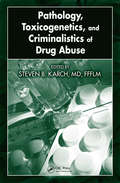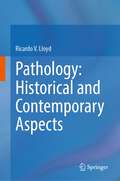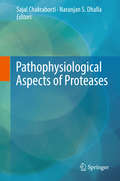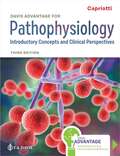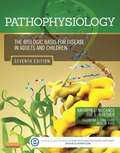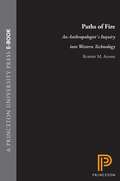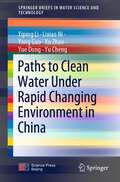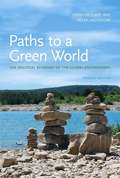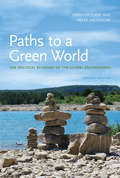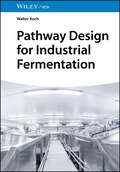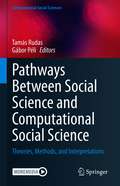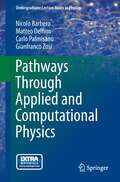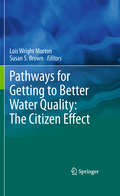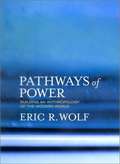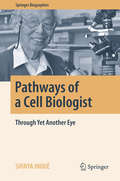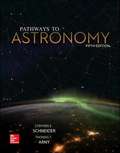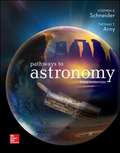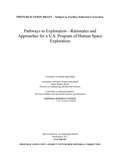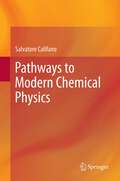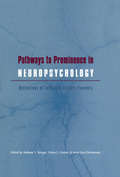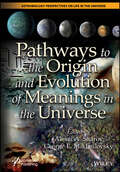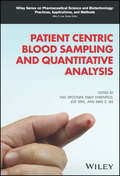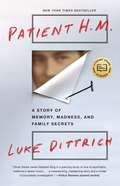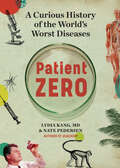- Table View
- List View
Pathology, Toxicogenetics, and Criminalistics of Drug Abuse
by Steven B. KarchBeginning with a definition and explanation of scheduling of controlled substances, Pathology, Toxicogenetics, and Criminalistics of Drug Abuse covers investigative methods for all illegal drugs and several legitimate pharmaceuticals that are used illicitly, including steroids. It covers the latest techniques used to analyze drugs in the forensic laboratory including physical characteristics and chemical confirmatory tests. It discusses new theories and findings in toxicogenetics, details pathologic changes in the body due to drug use, and examines specific effects on the heart, lung, and central nervous system. More that 70 tables and figures illustrate and complement the text and the information is supported by extensive references
Pathology: Historical and Contemporary Aspects
by Ricardo V. LloydThis book provides a broad overview of diagnostic pathology, integrating historical perspectives with the current practice of diagnostic pathology across various sub-fields such as surgical pathology, cytopathology, autopsy and forensic pathology, neuropathology and more. Pathology: Historical and Contemporary Aspects presents contemporary issues that are crucial to the practice of pathology in the 21st century, including the development and application of key techniques and technical aspects such as immunohistochemistry and molecular diagnostics, as well as computer applications such as image analysis and artificial intelligence. The history of the field in the West is covered in detail, including the history and current standing of major pathology societies, in addition to a concise overview of the development of pathology in Eastern countries such as China and Japan. It details the work of some outstanding individuals who have contributed to advances in pathology, from Nobel laureates to traditionally under-represented groups such as women and minorities.
Pathophysiological Aspects of Proteases
by Naranjan S. Dhalla Sajal ChakrabortiThis book provides a comprehensive overview of the multifaceted field of protease in the cellular environment and focuses on the recently elucidated functions of complex proteolytic systems in physiology and pathophysiology. Given the breadth and depth of information covered in the respective contributions, the book will be immensely useful for researchers working to identify targets for drug development. Multidisciplinary in scope, the book bridges the gap between fundamental and translational research, with applications in the biomedical and pharmaceutical industry, making it a thought-provoking read for basic and applied scientists engaged in biomedical research. Proteases represent one of the largest and most diverse families of enzymes known, and we now know that they are involved in every aspect of a given organism's life functions. Under physiological conditions, proteases are regulated by their endogenous inhibitors. However, when the activity of proteases is not correctly regulated, disease processes such as tumour progression, vascular remodelling, atherosclerotic plaque progression, ulcer, rheumatoid arthritis, Alzheimer's disease and inflammation can result. Many infective microorganisms require proteases for replication or use them as virulence factors, which has facilitated the development of protease-targeted therapies for a variety of parasitic diseases.
Pathophysiology: Introductory Concepts and Clinical Perspectives
by Theresa CapriottiDavis Advantage for Pathophysiology is a complete, integrated solution that combines a student-friendly textbook with personalized learning, clinical judgment, and quizzing assignments that engage learners, help them make the connections to key topics, prepare them for the Next Gen NCLEX®, and drive success. An access code inside new, printed textbooks unlocks an eBook, as well as access to Davis Advantage. Or, choose the all-digital Instant Access option which includes the eBook and immediate access to Davis Advantage. THE TEXTBOOK Chapters organized by body systems help students to understand the relationships between the underlying pathology and the patient assessment data, laboratory findings, and diagnostic testing results. Real-world perspectives bridge the gap between the science of disease and patient care.
Pathophysiology: The Biologic Basis for Disease in Adults and Children (Seventh Edition)
by Kathryn L. Mccance Sue E. HuetherWritten by well-known educators Kathryn McCance and Sue Huether, and joined by a team of expert contributors, this resource is the most comprehensive and authoritative pathophysiology text available! A fully updated glossary includes 1,000 terms, and makes lookup easier by grouping together similar topics and terms. Outstanding authors Kathryn McCance and Sue Huether have extensive backgrounds as researchers and instructors, and utilize expert contributors, consultants, and reviewers in developing this edition. Chapter summary reviews provide concise synopses of the main points of each chapter. Consistent presentation of diseases includes pathophysiology, clinical manifestations, and evaluation and treatment. Lifespan content includes ten separate pediatric chapters and special sections with aging and pediatrics content. Algorithms and flowcharts of diseases and disorders make it easy to follow the sequential progression of disease processes. Nutrition and Disease boxes explain the link between concepts of health promotion and disease. EXTENSIVELY Updated content reflects advances in pathophysiology including tumor biology invasion and metastases, the epidemiology of cancer, diabetes mellitus, insulin resistance, thyroid and adrenal gland disorders, female reproductive disorders including benign breast diseases and breast cancer, and a separate chapter on male reproductive disorders and cancer. NEW! Chapter on epigenetics and disease. Additional What's New boxes highlight the most current research and clinical development.
Paths of Fire: An Anthropologist's Inquiry into Western Technology
by Robert M. AdamsTechnology, perhaps the most salient feature of our time, affects everything from jobs to international law yet ranks among the most unpredictable facets of human life. Here Robert McC. Adams, renowned anthropologist and Secretary Emeritus of the Smithsonian Institution, builds a new approach to understanding the circumstances that drive technological change, stressing its episodic, irregular nature. The result is nothing less than a sweeping history of technological transformation from ancient times until now. Rare in antiquity, the bursts of innovations that mark the advance of technology have gradually accelerated and now have become an almost continuous feature of our culture. Repeatedly shifting in direction, this path has been shaped by a host of interacting social, cultural, and scientific forces rather than any deterministic logic. Thus future technological developments, Adams maintains, are predictable only over the very short term.Adams's account highlights Britain and the United States from early modern times onward. Locating the roots of the Industrial Revolution in British economic and social institutions, he goes on to consider the new forms of enterprise in which it was embodied and its loss of momentum in the later nineteenth century. He then turns to the early United States, whose path toward industrialization initially involved considerable "technology transfer" from Britain. Propelled by the advent of mass production, world industrial leadership passed to the United States around the end of the nineteenth century. Government-supported research and development, guided partly by military interests, helped secure this leadership.Today, as Adams shows, we find ourselves in a profoundly changed era. The United States has led the way to a strikingly new multinational pattern of opportunity and risk, where technological primacy can no longer be credited to any single nation. This recent trend places even more responsibility on the state to establish policies that will keep markets open for its companies and make its industries more competitive. Adams concludes with an argument for active government support of science and technology research that should be read by anyone interested in America's ability to compete globally.
Paths to Clean Water Under Rapid Changing Environment in China (SpringerBriefs in Water Science and Technology)
by Yu Cheng Yue Dong Yiping Li Xu Zhao Lixiao Ni Yong GuoThis book mainly provides the current status of water pollution faced by China under rapid changing environment and the actions that have been taken for prevention and treatment of water pollution. It points out that the water pollution situation is severe. Facing water pollution, China’s experiences include several aspects on source control and pollution interception, internal nutrient removal of sediment, ecological restoration, and water transfer policy. There exists both the opportunity and challenge for the prevention and control of water pollution in China. The book contains numerous charts and diagrams which further illustrating China’s paths to clean water.
Paths to a Green World
by Jennifer Clapp Peter DauvergneThis comprehensive and accessible book fills the need for a political economy view of global environmental politics, focusing on the ways international economic processes affect environmental outcomes. It examines the main actors and forces shaping global environmental management, particularly in the developing world. Moving beyond the usual emphasis on international agreements and institutions, it strives to capture not only academic theoretical debates but also views on politics, economics, and the environment within the halls of global conferences, on the streets during antiglobalization protests, and in the boardrooms of international agencies, nongovernmental organizations, and industry associations. The book maps out an original typology of four contrasting worldviews of environmental change--those of market liberals, institutionalists, bioenvironmentalists, and social greens--and uses them as a framework to examine the links between the global political economy and ecological change. This typology provides a common language for students, instructors, and scholars to discuss the issues across the classical social science divisions. The second edition of this popular text has been thoroughly revised and updated to reflect recent events, including the food crisis of 2007-2008, the financial meltdown of 2008, and the Copenhagen Climate Conference of 2009. Topics covered include the environmental implications of globalization; wealth, poverty, and consumption; global trade; transnational corporations; and multilateral and private finance.
Paths to a Green World, second edition: The Political Economy of the Global Environment
by Jennifer Clapp Peter DauvergneA new edition of a book that takes a comprehensive look at the ways economic processes affect global environmental outcomes. This comprehensive and accessible book fills the need for a political economy view of global environmental politics, focusing on the ways international economic processes affect environmental outcomes. It examines the main actors and forces shaping global environmental management, particularly in the developing world. Moving beyond the usual emphasis on international agreements and institutions, it strives to capture not only academic theoretical debates but also views on politics, economics, and the environment within the halls of global conferences, on the streets during antiglobalization protests, and in the boardrooms of international agencies, nongovernmental organizations, and industry associations. The book maps out an original typology of four contrasting worldviews of environmental change—those of market liberals, institutionalists, bioenvironmentalists, and social greens—and uses them as a framework to examine the links between the global political economy and ecological change. This typology provides a common language for students, instructors, and scholars to discuss the issues across the classical social science divisions.The second edition of this popular text has been thoroughly revised and updated to reflect recent events, including the food crisis of 2007-2008, the financial meltdown of 2008, and the Copenhagen Climate Conference of 2009. Topics covered include the environmental implications of globalization; wealth, poverty, and consumption; global trade; transnational corporations; and multilateral and private finance.
Pathway Design for Industrial Fermentation
by Walter KochPathway Design for Industrial Fermentation Explore the industrial fermentation processes of chemical intermediates In Pathway Design for Industrial Fermentation, distinguished researcher Dr. Walter Koch delivers an expert overview on industrial fermentation production technology as compared with natural extraction, organic chemistry, and biocatalysis. The book offers key insights for professionals designing and monitoring fermentation processes. The author explores the applications, alternative production, biochemical pathways, metabolic engineering strategy, and downstream processing of various products—including C1 to C6 products—with a focus on low-value products with market prices below 4€ per kilogram. Products will include methane, ethane, acetate, lactic acid, alanine, and others. With specific commentary and insightful perspectives on the cost drivers and technological aspects critical to commercially successful applications, the book also includes: Thorough introductions to methane, ethanol, acetate, lactic acid, alanine, and 3-Hydroxypropionic acid Comprehensive explorations of 1,3-Propanediol, butanol, isobutanol, and isobutene Practical discussions of 1,4-butanediol, succinic acid, itaconic acid, and glutamic acid Fulsome treatments of isoprene, pentamethylenediamine, lysine, citric acid, and adipic acid Perfect for process engineers, biotechnologists, and chemical engineers, Pathway Design for Industrial Fermentation will also benefit biochemists and professionals working in the chemical and food industries.
Pathways Between Social Science and Computational Social Science: Theories, Methods, and Interpretations (Computational Social Sciences)
by Tamás Rudas Gábor PéliThis volume shows that the emergence of computational social science (CSS) is an endogenous response to problems from within the social sciences and not exogeneous. The three parts of the volume address various pathways along which CSS has been developing from and interacting with existing research frameworks. The first part exemplifies how new theoretical models and approaches on which CSS research is based arise from theories of social science. The second part is about methodological advances facilitated by CSS-related techniques. The third part illustrates the contribution of CSS to traditional social science topics, further attesting to the embedded nature of CSS. The expected readership of the volume includes researchers with a traditional social science background who wish to approach CSS, experts in CSS looking for substantive links to more traditional social science theories, methods and topics, and finally, students working in both fields.
Pathways Through Applied and Computational Physics
by Nicolò Barbero Matteo Delfino Carlo Palmisano Gianfranco ZosiThis book is intended for undergraduates and young researchers who wish to understand the role that different branches of physics and mathematics play in the execution of actual experiments. The unique feature of the book is that all the subjects addressed are strictly interconnected within the context of the execution of a single experiment with very high accuracy, namely the redetermination of the Avogadro constant NA, one of the fundamental physical constants. The authors illustrate how the basic laws of physics are applied to describe the behavior of the quantities involved in the measurement of NA and explain the mathematical reasoning and computational tools that have been exploited. It is emphasized that all these quantities, although pertaining to a specific experiment, are of wide and general interest. The book is organized into chapters covering the interaction of electromagnetic radiation with single crystals, linear elasticity and anisotropy, propagation of thermal energy, anti-vibration mounting systems, and data analysis and B-spline interpolation. An essential feature is the focus on the role of Mathematica, an invaluable, fully integrated software environment for handling diverse scientific and technical computations.
Pathways for Getting to Better Water Quality: The Citizen Effect
by Susan S. Brown Lois Wright MortonThis book is about accomplishing change in how land is managed in agricultural watersheds. Wide-ranging case studies repeatedly document that plans, policies, and regulations are not adequate substitutes for the empowerment of people. Ultimately change on the land is managed and accomplished by the people that live on land within each watershed.
Pathways of Power: Building an Anthropology of the Modern World
by Eric R. WolfPosthumous collection of one of the world's leading anthropologists, spanning well over half a century of scholarship and including both well-known pieces, lesser-known not-easily-accessible pieces, and a few entirely unpublished pieces.
Pathways of a Cell Biologist
by Shinya InouéThis book is the autobiography of Shinya Inoué, tracing his life from childhood to the present. Though he has made many contributions to science, perhaps the most remarkable one involves the visualization of dynamics in living cells by means of a polarizing light microscope, an innovation that changed the face of cell biology. Addressing readers curious to know why and how he achieved such success, the story begins with a prologue describing the end of World War II and Inoué's lifelong collaborator, the great cell biologist Katsuma Dan. Following the prologue, the author's childhood and teenage experiences during World War II are described, before the focus shifts to his scientific career and personal life. The book not only offers important tips for young researchers, it will also help them develop a passion for science.
Pathways to Astronomy (Fifth Edition)
by Thomas T. Arny Stephen E. SchneiderCreated by two veteran teachers of astronomy, both recipients of outstanding teaching awards, Pathways breaks down introductory astronomy into its component parts. The huge and fascinating field of astronomy is divided into 86 Units from which you can selectively choose topics according to your interests, while maintaining a natural flow of presentation. One of the frustrations created by other current astronomy textbooks is that each chapter covers such a wide array of topics that it is difficult for students to absorb the large amount of material, and the texts are wed to such a specific order of presentation that it is difficult for the professor to link the chapter readings and review questions to his or her own particular approach to teaching the subject. Whether you are learning astronomy for the first time or teaching it for the tenth, Pathways offers greater flexibility for exploring astronomy in the way you want to.
Pathways to Astronomy (Fourth Edition)
by Thomas Arny Stephen Schneider<p>Created by two veteran teachers of astronomy, both recipients of outstanding teaching awards, Pathways breaks down introductory astronomy into its component parts. The huge and fascinating field of astronomy is divided into 86 Units from which you can selectively choose topics according to your interests, while maintaining a natural flow of presentation. One of the frustrations created by other current astronomy textbooks is that each chapter covers such a wide array of topics that it is difficult for students to absorb the large amount of material, and the texts are wed to such a specific order of presentation that it is difficult for the professor to link the chapter readings and review questions to his or her own particular approach to teaching the subject. <p>Whether you are learning astronomy for the first time or teaching it for the tenth, Pathways offers greater flexibility for exploring astronomy in the way you want to. The Unit structure allows the new learner and the veteran professor to relate the text more clearly to college lectures. Each Unit is small enough to be easily tackled on its own or read as an adjunct to the classroom lecture. For the faculty member who is designing a course to relate to current events in astronomy or a particular theme, the structure of Pathways makes it easier to assign reading and worked problems that are relevant to each topic. For the student of astronomy, Pathways makes it easier to digest each topic and to clearly relate each Unit to lecture material.</p>
Pathways to Exploration: Rationales and Approaches for a U.S. Program of Human Space Exploration
by Committee on Human SpaceflightThe United States has publicly funded its human spaceflight program on a continuous basis for more than a half-century, through three wars and a half-dozen recessions, from the early Mercury and Gemini suborbital and Earth orbital missions, to the lunar landings, and thence to the first reusable winged crewed spaceplane that the United States operated for three decades. Today the United States is the major partner in a massive orbital facility - the International Space Station - that is becoming the focal point for the first tentative steps in commercial cargo and crewed orbital space flights. And yet, the long-term future of human spaceflight beyond this project is unclear. Pronouncements by multiple presidents of bold new ventures by Americans to the Moon, to Mars, and to an asteroid in its native orbit, have not been matched by the same commitment that accompanied President Kennedy\'s now fabled 1961 speech-namely, the substantial increase in NASA funding needed to make it happen. Are we still committed to advancing human spaceflight? What should a long-term goal be, and what does the United States need to do to achieve it? "Pathways to Exploration" explores the case for advancing this endeavor, drawing on the history of rationales for human spaceflight, examining the attitudes of stakeholders and the public, and carefully assessing the technical and fiscal realities. This report recommends maintaining the long-term focus on Mars as the horizon goal for human space exploration. With this goal in mind, the report considers funding levels necessary to maintain a robust tempo of execution, current research and exploration projects and the time/resources needed to continue them, and international cooperation that could contribute to the achievement of spaceflight to Mars. According to "Pathways to Exploration," a successful U. S. program would require sustained national commitment and a budget that increases by more than the rate of inflation. In reviving a U. S. human exploration program capable of answering the enduring questions about humanity's destiny beyond our tiny blue planet, the nation will need to grapple with the attitudinal and fiscal realities of the nation today while staying true to a small but crucial set of fundamental principles for the conduct of exploration of the endless frontier. The recommendations of "Pathways to Exploration" provide a clear map toward a human spaceflight program that inspires students and citizens by furthering human exploration and discovery, while taking into account the long-term commitment necessary to achieve this goal.
Pathways to Modern Chemical Physics
by Salvatore CalifanoIn this historical volume Salvatore Califano traces the developments of ideas and theories in physical and theoretical chemistry throughout the 20th century. This seldom-told narrative provides details of topics from thermodynamics to atomic structure, radioactivity and quantum chemistry. Califano's expertise as a physical chemist allows him to judge the historical developments from the point of view of modern chemistry. This detailed and unique historical narrative is fascinating for chemists working in the fields of physical chemistry and is also a useful resource for science historians who will enjoy access to material not previously dealt with in a coherent way.
Pathways to Prominence in Neuropsychology: Reflections of Twentieth-Century Pioneers
by Anthony Y. Stringer Eileen L. Cooley Anne-Lise ChristensenCaptures the stories behind the work of the clinicians and scholars who have contributed significantly to neuropsychology's development.
Pathways to the Origin and Evolution of Meanings in the Universe (Astrobiology Perspectives on Life in the Universe)
by Alexei A. Sharov George E. MikhailovskyPathways to the Origin and Evolition of Meanings in the Universe The book explains why meaning is a part of the universe populated by life, and how organisms generate meanings and then use them for creative transformation of the environment and themselves. This book focuses on interdisciplinary research at the intersection of biology, semiotics, philosophy, ethology, information theory, and the theory of evolution. Such a broad approach provides a rich context for the study of organisms and other semiotic agents in their environments. This methodology can be applied to robotics and artificial intelligence for developing robust, adaptable learning devices. In this book, leading interdisciplinary scholars reveal their vision on how to integrate natural sciences with semiotics, a theory of meaning-making and signification. Developments in biology indicate that the capacity to create and understand signs is not limited to humans or vertebrate animals, but exists in all living organisms - the fact that inspired the integration of biology and semiotics into biosemiotics. The authors discuss the nature of semiotic agents (organisms and other autonomous goal-directed units), meaning, signs, information, memory, evolution, and consciousness. Also discussed are issues including the origin of life, potential meaning and its actualization, top-down causality in physics and biology, capacity of organisms to encode their functions, the strategy of organisms to combine homeostasis with direct adaptation to new life-cycle phases or new environments, multi-level memory systems, increase of freedom via enabling constraints, creative modeling in evolution and learning, communication in animals and humans, the origin and function of language, and the distribution and transfer of life in space. This is the first book on biosemiotics in its global conceptual and spatial scope. Biosemiotics is presented using the language of natural sciences, which supports the scientific grounding of semiotic terms. Finally, the cosmic dimension of life and meaning-making leads to a reconsideration of ethical principles and ecological mentality here on earth and in space exploration. Audience Theoretical biologists, ethologists, astrobiologists, ecologists, evolutionary biologists, philosophers, phenomenologists, semioticians, biosemioticians, molecular biologists, linguists, system scientists and engineers.
Patient Centric Blood Sampling and Quantitative Analysis (Wiley Series on Pharmaceutical Science and Biotechnology: Practices, Applications and Methods)
by Mike S. Lee Neil Spooner Emily Ehrenfeld Joe SiplePATIENT CENTRIC BLOOD SAMPLING AND QUANTITATIVE ANALYSIS Authoritative resource providing a complete overview of patient centric blood sampling, as well as its benefits and challenges Patient Centric Blood Sampling and Quantitative Analysis focuses on the growing interest in alternative means to standard phlebotomy and analytical workflows for the collection and analysis of high-quality human biological samples for the quantitative determination of circulating drugs, their metabolites, and endogenous substances for clinical trials, routine healthcare and neonatal screening. The book clearly explains the benefits and constraints of having patients collect small volumes of blood in locations outside of a clinic (e.g at home), including: patient convenience; less invasive procedures; increased frequency of sampling; applicability to collecting samples from the young, elderly, and those in remote locations; greater frequency; and lower cost per sample. Readers will learn about approaches for successfully implementing patient centric sampling workflows in a number of scenarios, including the clinical setting and in the analytical laboratory. Edited by four recognized experts in this field, with additional specialists in the discipline enlisted to write the component chapters, enabling greater depth and detail to be added and further raising the scientific standing of the publication, Patient Centric Blood Sampling and Quantitative Analysis includes information on: Basics of patient centric blood sampling and techniques and approaches that are available and in development for the collection and analysis of the samples Science behind patient centric blood sampling and its implications regarding human healthcare and wellbeing Application areas of patient centric sampling, including drug development, clinical chemistry/pathology, therapeutic drug monitoring, and more Practical approaches to successful implementation for existing and developing purposes and workflows, and case studies to support implementation within an organization Giving the reader a broad understanding of what patient centric sampling is and where it might be applied for existing and potential future areas, Patient Centric Blood Sampling and Quantitative Analysis is an essential resource on the subject for many different types of laboratories, areas of clinical research and healthcare, including those in pharmaceutical, clinical, and research functions.
Patient Compliance with Medications: Issues and Opportunities
by Richard SchulzImprove your patient&’s health through a fresh view of their behaviorsPatients who use over-the-counter (OTC) and prescription medicine often do not take the drugs as intended, sometimes to the detriment to their health and well-being. These widespread problems cause health professionals to agonize over how to try to make sure pati
Patient H.M.: A Story of Memory, Madness, and Family Secrets
by Luke Dittrich"Oliver Sacks meets Stephen King"* in this propulsive, haunting journey into the life of the most studied human research subject of all time, the amnesic known as Patient H.M., a man who forever altered our understanding of how memory works--and whose treatment raises deeply unsettling questions about the human cost of scientific progress. For readers of The Immortal Life of Henrietta Lacks comes a story that has much to teach us about our relentless pursuit of knowledge. *Kirkus Reviews (starred review) In 1953, a twenty-seven-year-old factory worker named Henry Molaison--who suffered from severe epilepsy--received a radical new version of the then-common lobotomy, targeting the most mysterious structures in the brain. The operation failed to eliminate Henry's seizures, but it did have an unintended effect: Henry was left profoundly amnesic, unable to create long-term memories. Over the next sixty years, Patient H.M., as Henry was known, became the most studied individual in the history of neuroscience, a human guinea pig who would teach us much of what we know about memory today. Patient H.M. is, at times, a deeply personal journey. Dittrich's grandfather was the brilliant, morally complex surgeon who operated on Molaison--and thousands of other patients. The author's investigation into the dark roots of modern memory science ultimately forces him to confront unsettling secrets in his own family history, and to reveal the tragedy that fueled his grandfather's relentless experimentation--experimentation that would revolutionize our understanding of ourselves. Dittrich uses the case of Patient H.M. as a starting point for a kaleidoscopic journey, one that moves from the first recorded brain surgeries in ancient Egypt to the cutting-edge laboratories of MIT. He takes readers inside the old asylums and operating theaters where psychosurgeons, as they called themselves, conducted their human experiments, and behind the scenes of a bitter custody battle over the ownership of the most important brain in the world. Patient H.M. combines the best of biography, memoir, and science journalism to create a haunting, endlessly fascinating story, one that reveals the wondrous and devastating things that can happen when hubris, ambition, and human imperfection collide.Praise for Patient H.M."An exciting, artful blend of family and medical history."--The New York Times"Patient H.M. tells one of the most fascinating and disturbing stories in the annals of medicine, weaving in ethics, philosophy, a personal saga, the history of neurosurgery, the mysteries of human memory, and an exploration of human ego."--Sheri Fink, M.D., Pulitzer Prize winner and author of Five Days at Memorial "Dittrich explores the limits of science and the mind. In the process, he rescues an iconic life from oblivion. Dittrich is well aware that while we are the sum of what we may remember, we're also at the mercy of what we can forget. This is classic reporting and myth-making at the same time."--Colum McCann, author of Let the Great World Spin "This book succeeds on every level: as a fresh look at the most famous patient in medical history, as an exposé of our dark history of psychiatry and neurosurgery, and, most powerfully, as a deeply personal investigation into the author's past. And yet it's still a page-turner that reads like a thriller."--Susannah Cahalan, author of Brain on FireFrom the Hardcover edition.
Patient Zero: A Curious History of the World's Worst Diseases
by Lydia Kang Nate PedersenFrom the masters of storytelling-meets-science and co-authors of Quackery, Patient Zero tells the long and fascinating history of disease outbreaks—how they start, how they spread, the science that lets us understand them, and how we race to destroy them before they destroy us. Written in the authors&’ lively and accessible style, chapters include page-turning medical stories about a particular disease or virus—smallpox, Bubonic plague, polio, HIV—that combine &“Patient Zero&” narratives, or the human stories behind outbreaks, with historical examinations of missteps, milestones, scientific theories, and more. Learn the tragic stories of Patient Zeros throughout history, such as Mabalo Lokela, who contracted Ebola while on vacation in 1976, and the Lewis Baby on London&’s Broad Street, the first to catch cholera in an 1854 outbreak that led to a major medical breakthrough. Interspersed are origin stories of a different sort—how a rye fungus in 1951 turned a small village in France into a phantasmagoric scene reminiscent of Burning Man. Plus the uneasy history of human autopsy, how the HIV virus has been with us for at least a century, and more.
